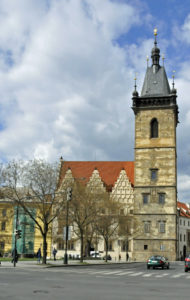
New Town Hall in Prague (Photo by Don Knebel)
Prague was founded in the ninth century on a hill that now includes the largest castle complex in the world. In about 1402, Jan Hus, a Prague priest, began preaching against what he saw as the excesses of the Roman Catholic Church. After Catholics burned Hus at the stake for heresy in 1415, his “Hussite” followers continued advocating for religious reforms. In 1419, a group of Hussites marched to Prague’s New Town Hall, which had been built southeast of the original city by Charles IV, the King of Bohemia. The marchers demanded the release of sympathizers being held prisoner by local officials. When someone inside threw a rock, the Hussites stormed the building and tossed the chief magistrate and his council out a tower window, killing seven council members.
In 1618, spiritual descendants of these early Protestants went to the Prague Castle, demanding the right to worship as they chose. When representatives of the Habsburg rulers rejected their demands, the Protestants mimicked the acts of their predecessors and threw the Catholics out a third story window. They somehow survived the fall. Catholics said they were caught by angels and Protestants said they fell on a pile of cow manure. The term “defenestrations of Prague” came to describe these acts of flinging religious rivals out the window. The second defenestration led to the Thirty Years’ War that eventually enveloped much of Europe.
Today, a massive statue of Jan Hus dominates Prague’s popular Old Town Square. The tower of the New Town Hall, offering stunning views of the city, has heavy screens across its upper windows.
Comments are closed.